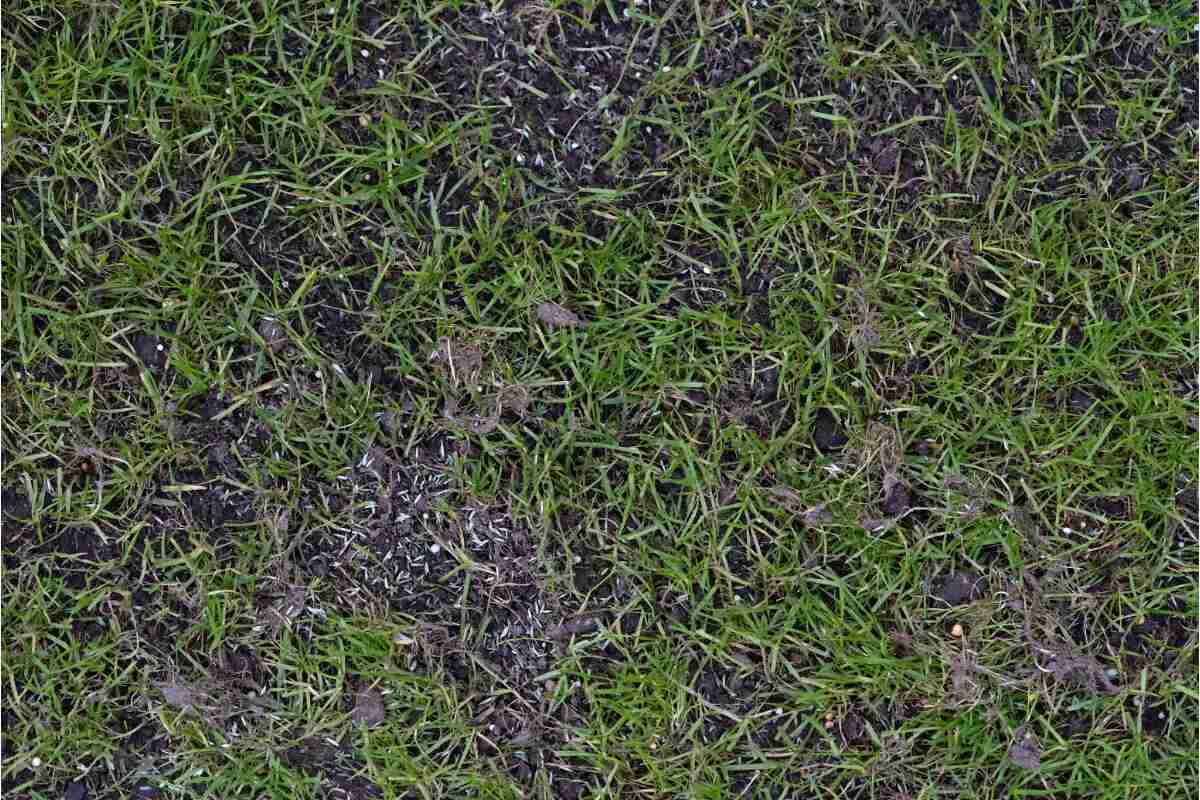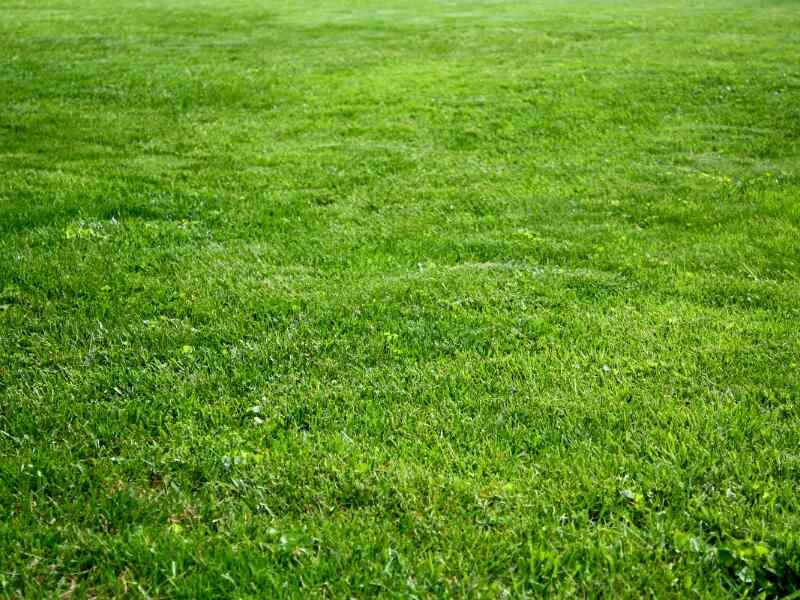
Spring or early fall are the best times to overseed lawns in Indiana. At this time, your lawn is primed to germinate new grass seeds because the soil temperature is in the perfect range, between about 50 to 65 degrees.
In this article, we’ll walk you through the process of overseeding your Indiana lawn, helping you create a thicker, healthier, and greener swath of lush grass.
When is the Best Time to Overseed in Indiana?
The best time to overseed your Indiana lawn is in spring or early fall, between September and early October. Here’s why:
Early Fall Overseeding
As the summer heat begins to subside in late summer to early fall, the temperature becomes more friendly to cool-season grass seeds, which are the most popular types of grass across Indiana. This is also the best time to plant grass seeds in Indiana for a new lawn because the cool-season grass will grow vigorously throughout the fall.
After absorbing the summer heat, the soil is pleasantly warm but not too hot, with a temperature between 50 to 65 degrees, which is critical for supporting seed germination in cool-season grasses. This warm soil and cooler temperature create a favorable environment for the seeds, allowing them to take root and flourish.
At this time, the increased possibility of rainfall is also beneficial for overseeding, as it reduces the efforts required to water the grass seeds often. The extra moisture is essential for effective seed germination.
A combination of warm soil and enough moisture in early fall produces an ideal environment for grass seeds to sprout and grow swiftly. Your lawn is also not so prone to weeds at this time, which gives your new grass enough space to grow without competition.
Pro tips for early fall overseeding:
- Don’t overseed right after rainfall because the wet ground is unsuitable for seed growth. Also, avoid overseeding when rain is in the forecast within the next few days because the rain could wash out your seeds.
- Always overseed at least 45 days before the first frost because, after that, your new grass won’t have enough time to establish before going dormant for winter. Most of Indiana gets the first frost of the year in mid-October.
Spring Overseeding
Although you can overseed your lawn in spring because the soil is just starting to warm, and cool-season grasses have a growth spurt in spring, there are downsides to overseeding in spring.
Here’s why: The harsh heat of the upcoming summer can harm the young, vulnerable grass seedlings and waste all your efforts. Also, weeds that germinate in spring can become a serious problem because your grass has to fight these unwanted plants for nutrients and water.
Indicators Your Lawn Needs Overseeding

Sometimes, your grass shows signs that demand overseeding the lawn as soon as possible, whether that’s early fall or spring. These indicators include:
- Thin grass or bare spots: If you find thin grass or barren spots or patches in your lawn, overseeding is the best and fastest way to fill in the blanks, especially if you have a grass type like perennial ryegrass, tall fescue, or most fine fescues, which spread slowly and have a hard time filling bare spots on their own.
- Weeds have taken over: When weeds take over your lawn, your grass isn’t as healthy or dense as it should be. Overseeding with new grass seeds can help crowd out those weeds.
- Stress from weather conditions: Extreme weather conditions like drought or even too much rainfall can strain turf. Overseeding with suitable grass types might help your Indiana lawn endure these stressors and stay healthy.
- Pest or disease damage: Pest and disease infestation usually disrupt healthy turf growth in your lawn. Overseeding with disease-resistant or pest-resistant grass species like tall fescue can help you revive your Indiana lawn.
- Heavy foot traffic: Lawns that experience heavy foot traffic, whether from kids playing or adults hosting outdoor events, can show signs of wear and tear. Overseeding aids in rehabilitating these high-traffic areas while maintaining a lush appearance.
Keep an eye out for these symptoms in your lawn, and if you see them, think about overseeding as a strategy to withstand drought conditions, prevent weed growth, and ultimately maintain a healthy lawn.
How to Overseed Your Lawn
Now that you know the best time for overseeding in Indiana, here’s a step-by-step guide on how to overseed your lawn DIY:
Step 1: Gather Materials and Tools
Essential tools and materials you might need for overseeding include:
- Rake
- Lawn mower
- Starter fertilizer
- Broadcast spreader
- Cool-season grass seeds
- Core or spike aerator
Step 2: Examine Your Lawn
Walk around your lawn and look for thin or bare sections that need to be overseeded. Mark these locations as needing special attention. Measure the areas you’ve marked to calculate how much grass seed you need to buy.
Step 3: Prepare the Lawn
Mow your lawn to around 2 inches in height and carefully rake the area to loosen the top layer of soil and eliminate any debris, such as leaves or grass clippings. If there is a thick layer of thatch on top of the soil, you can dethatch your lawn to remove it.
If the soil is compacted, aerate it with a spike aeration tool or core aeration machine to loosen the soil and make it easier for your new grass to establish roots. Luckily, fall is also the best time to aerate your lawn in Indiana, so aeration and overseeding pair well together.
Once the soil is loose and clear of debris, add about a ¼-inch thick layer of enriched topsoil to your lawn.
Step 4: Select the Best Grass Seed
Choose a grass seed blend suited to your region of the state, the amount of sunlight your lawn gets, and the amount of work you’re willing to put in to maintain your lawn. Cool-season grasses like Kentucky bluegrass, perennial ryegrass, fine fescues, and tall fescue are usually the best grass seed options for Indiana lawns.
Step 5: Spread the Seed
Fill a broadcast fertilizer spreader with your desired grass seed and begin pushing the spreader across your lawn in parallel rows to spread the seed as evenly as possible. Pay special attention to the identified problem areas to ensure complete coverage, maybe even going over them two or three times.
Step 6: Press the Seeds into the Soil
This step is optional, but pressing the seeds into the soil increases the chances of your new grass seeds growing successfully. You can go over your lawn with a lawn roller to gently press the grass seeds into the soil and improve the seed-to-soil contact.
Step 7: Apply Starter Fertilizer
With your fertilizer spreader, apply a lawn starter fertilizer all over your lawn for better grass growth and root development.
Step 8: Water Your Lawn
Water your lawn thoroughly immediately after applying the starter fertilizer to help the grass seed settle into the soil and start germination. Water the soil for the next two weeks to promote healthy growth.
Step 9: Routine Maintenance
Wait for the new grass to grow and reach the same height as the mature grass already in your lawn. Then, continue with regular lawn care, such as mowing, watering, and adding proper fertilizers for better turf health.
Why Overseeding is Important

Overseeding entails spreading grass seed over your already established lawn to refill bare spots and thin grass. It makes your grass grow thicker, which can help prevent weeds and improve your lawn’s drought and heat resistance. Overseeding is like hair plugs for your lawn, and it’s critical for several reasons, including:
- Overseeding improves the density of your lawn. Lawns can become patchy or thin in certain spots over time due to foot traffic, pests, diseases, or simply normal wear and tear. Overseeding helps you fill in those empty spots and make your lawn look green and luscious.
- Overseeding allows you to change the look and growth characteristics of your grass. You can experiment with different grass types or grass mixes to improve your lawn’s capacity to adapt to changing weather conditions in Indiana. Different grass types can provide your lawn with various colors, textures, and shade tolerance, too.
FAQ About Overseeding in Indiana
What type of fertilizer should I use after overseeding?
Choose a balanced starter fertilizer with a relatively low nitrogen content for better grass growth. Look for an N-P-K ratio of 10-10-10.
After this application of starter fertilizer, you should put your lawn on a regular fertilization schedule. The right times to fertilize lawns in Indiana are spring (April through May), early fall (September through October), and late fall (six weeks before the first frost).
Can I mow my lawn after overseeding?
Wait until the new grass is at least 2 to 3 inches tall before mowing your lawn after overseeding, and ensure the lawn mower blade is sharp to avoid damaging the seedlings.
How often should I overseed my lawn?
To maintain a thick lawn, you should overseed once every year. However, you also have the option to wait until your grass looks like it could use a pick-me-up.
Hire a Pro to Overseed Your Indiana Lawn
Overseeding is a powerful tool to rejuvenate and maintain a lush cool-season lawn in Indiana. By understanding the when, how, and why of overseeding, you can transform your lawn into a vibrant oasis ready to withstand the challenges of the changing seasons. But understanding isn’t enough. You also need the time and energy to plant and take care of new grass seeds.
If you don’t have time in your busy schedule to overseed your own lawn and perform other regular lawn maintenance tasks, LawnStarter can help. Just enter your address to find the best LawnStatter pros in Indiana, no matter where you live in the Hoosier State.
Main Photo Credit: Artur Henryk Bialosiewicz / Canva Pro / License